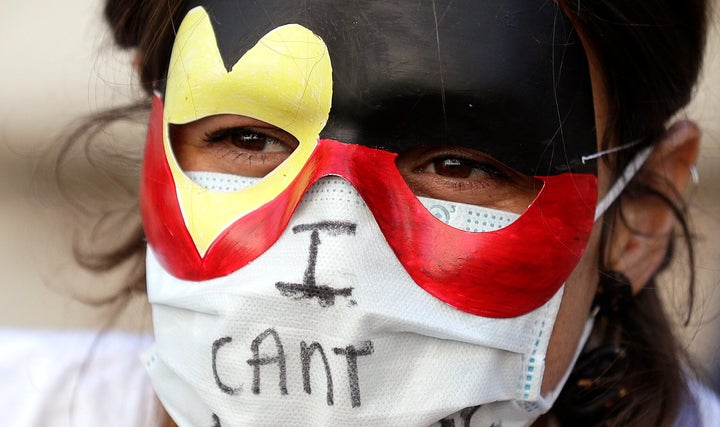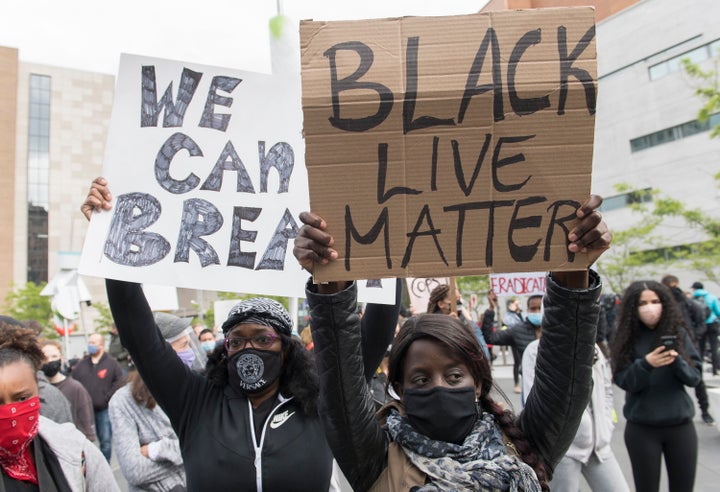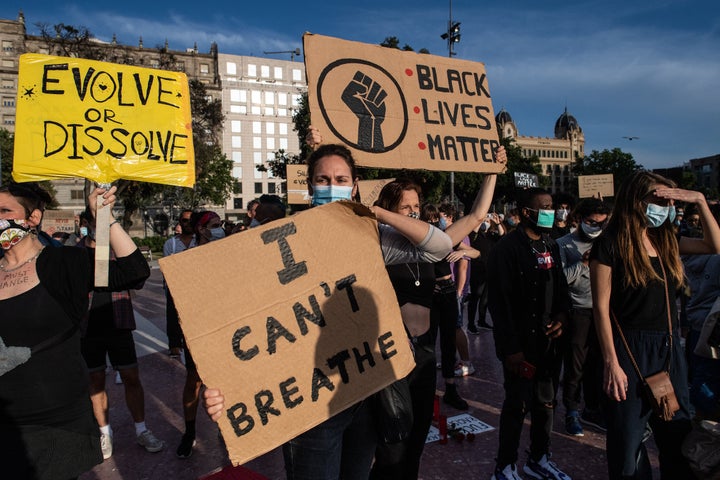
One of the first steps of responsible allyship is educating yourself on the issues you purport to support.
Right now, that step feels more pertinent than ever, as Black Lives Matter protests following the death of George Floyd continue across the United States and around the world.
For allies of Black and First Nations people and the Black Lives Matter movement, particularly white allies, you may be afraid to speak out and ask questions, or not want to burden Black people with educating you. It’s on us to take the time to educate ourselves if we aren’t already aware of how racism impacts the world around us.
You’ve likely seen various iterations of anti-racist readings lists circulating on social media this week, and those are great! It’s important to deeply consider these issues not just now, but every day. It’s also important to support Black organisations and businesses.

But more of us than would like to admit still need to start with the basics. Do you know what systemic racism is? Or what makes a microaggression? What’s your understanding of white privilege?
It’s important to understand these terms, names and phrases and how they impact society. If you are an ally, one of the best things you can do is talk about these issues with other allies. Bring them up in your workplace, and interrogate where the gaps in your own knowledge are.
With that in mind, this is an alphabetical glossary of basic terms, names and phrases to get you started talking about what’s going on right now in relation to anti-Black racism and the Black Lives Matter movement. It’s not an exhaustive list, nor is it supposed to be. It’s a starting point for further reading and further action. Several books have been written on some of these words — this is just the tip of the iceberg.
One last note: words have power, and how we define them has power. If you are an ally, listen to the communities you purport to support and how they use and invoke these words. Take your cues from them.
Ally:
An ally is someone who is not part of a marginalised group that works to support, uplift and work towards justice for that group.
There are many different ways white and non-Black people of colour can be good allies to Black people, from mobilising their privilege to enact change, to elevating and amplifying Black voices, to stepping back and listening, rather than dominating the conversation. True allyship is about taking issues of racism or oppression that may not directly affect your yourself up as your cause and doing the work to dismantle them.
Read more: A Guide To Allyship
Anti-racism:
Rather than simply not being racist, being anti-racist is an active state of working to make things better by dismantling racist structures, fighting oppression and working towards justice. According to the Alberta Civil Liberties Research Centre, “Anti-racism is an active way of seeing and being in the world, in order to transform it.” It’s about working in your workplace, school, community and other areas of society to actively challenge racism.
Read more: “How To Be An Anti-Racist” by Ibram X. Kendi.
Black:
Black is used broadly to describe people of African-descent populations, including Caribbean, African American and other diasporic groups.
But its capitalisation is also significant. Writer and professor Lori L Tharps argued in the New York Times in 2014, “Black with a capital B refers to people of the African diaspora. Lowercase black is simply a colour.” It’s a way of recognising Black as an identity, not just an adjective.
“For me, in the era of Black Lives Matter, capital-B Black is an act of defiance against a society that often paints minorities as secondary,” wrote Toronto writer Eternity Martis in 2016.
Read more: “Post-Black: How A New Generation Is Redefining African American Identity” by Ytasha Womack.
Black Lives Matter:
Black Lives Matter was originally created in the US by Patrisse Cullors, Opal Tometi and Alicia Garza as a call to action for Black people after the killing of 17-year-old Trayvon Martin by George Zimmerman. It’s grown into an international movement, with chapters around the world working to oppose anti-Black racism and police brutality in their local communities.

Derek Chauvin:
Derek Chauvin is the white Minneapolis police officer who is charged in the killing of George Floyd. Two other officers further restrained Floyd while a fourth prevented onlookers from intervening. All four officers were fired after the incident, with only Chauvin initially charged.
On Wednesday, one of Chauvin’s charges was upgraded to second-degree murder and the office of Minnesota Attorney General Keith Ellison charged Tou Thao, Thomas Lane and J Alexander Kueng with aiding and abetting Floyd’s murder.
David Dungay Jr
“I can’t breath” were the last words not only of George Floyd, but of Aboriginal man David Dungay Jr as he laying dying on the floor of his Long Bay jail cell in Australia, a case strikingly similar to the one that has sparked mass protests against racial injustice.
The death of 26-year-old Dungay in 2015 garnered relatively little attention in Australia, where First Nations people account for a disproportionate number of prisoners and rank near the bottom on economic and social indicators.
But the reaction to Floyd’s death in Minneapolis has inspired protests in major Australian cities to turn the spotlight on Indigenous plight.
Indigenous Australians are the most incarcerated people in the world.
Despite making up about 2% of Australia’s population, they account for 28% of the adult prison population.
George Floyd:
A 46-year-old Black man who died in Minneapolis on May 25 after Chauvin pressed his knee into his neck for almost nine minutes while Floyd was handcuffed and lying face-down on the street. Floyd was unresponsive for the final three minutes of that time. His death has sparked a wave of protests across the US and around the world after video footage of the incident circulated online. While a Hennepin County medical examiner determined Floyd’s death could be related to preexisting health conditions, an independent autopsy found “evidence is consistent with mechanical asphyxia as the cause” of death, with neck compression restricting blood flow to the brain, and back compression restricting breathing.
Floyd was a father of two daughters, the youngest of which was six years old. According to friends and family, those who knew him best called him “Floyd,” and he had a reputation as “someone who had your back and was there for you when you were down.”
“I Can’t Breathe”:
You’ve likely seen this written on signs or chanted during protests. It’s been a slogan and rallying cry of the Black Lives Matter movement. They were Eric Garner’s final words before his death at the hands of New York police in 2014. Video from the incident shows Garner repeating it 11 times before losing consciousness.
“I can’t breathe” were also Floyd’s final words, reigniting as a phrase of the movement in recent weeks.
“I can’t breathe, please don’t! Let me up, please! Help please! I can’t breathe!” were also David Dungay Jr’s last word.
Microaggressions:
Psychologist Derald W Sue defines microaggressions as “The everyday slights, indignities, put downs and insults that people of colour, women, LGBT populations or those who are marginalised experience in their day-to-day interactions with people.”
Microaggressions often might seem like a compliment or a joke but contain hidden insults, in this context based on someone’s identity. So, when someone says, “You don’t look Aboriginal,” or “You’re smarter than I expected,” or “Your English is really good,” that’s a microaggression.
They continue as a way of covertly reinforcing white supremacy in our day-to-day systems and society. Harvard professor Chester M Pierce coined the term in the 1970s, specifically in the context of interactions between white and Black people.
““Anti-racism is an active way of seeing and being in the world, in order to transform it.””
“The major vehicle for racism (in the US) is offences done to Blacks by whites in this sort of gratuitous neverending way. These offences are microaggressions,” he wrote. “Almost all Black-white racial interactions are characterised by white put-downs, done in automatic, preconscious, or unconscious fashion.”
“No Justice, No Peace”:
A phrase first popularised by Rev. Al Sharpton in 1986, as, in his words, “a rallying cry each and every time a grave miscarriage of justice has befallen the disenfranchised.” The slogan has garnered recent popularity as part of the Black Lives Matter movement.
″’No justice, no peace’ means that, until we see fairness and accountability, we will not remain silent,” Sharpton said.
Performative allyship:
Also known as performative activism, performative wokeness or “slacktivism,” performative allyship refers to signalling or showing your allyship or “good opinions,” often through social media, without doing the actual work of being an ally or activist. You’re likely familiar with it from the debates and discussions around the recent #Blackout trend on Instagram. And while the intent behind this sort of action is usually good, it’s important to interrogate why you’re publicly announcing your allyship, and what goal that achieves.
“Many people, white people, who have been largely mute on these issues until this point are now doing what they can to detract from their own previous apathy in the form of screenshotted donations and fervent threads, rushing to prove they’re not like those “other” silent white people, quickly writing captions decrying complicity that was theirs until last week,” Yomi Adegoke wrote.
WATCH: Lil Nas X says “blackout Tuesday” was the “worst idea ever.” Story continues below.
POC or BIPOC:
Acronym for “person of colour” or “Black, Indigenous or person of colour,” usually used to refer to people who identify or are perceived as non-white. Many choose to use BIPOC to highlight the unique experiences of Black or Indigenous people independent of other people of colour, and push back against a definition of people as “one-size-fits-all.”
There’s a dark history of the phrase “coloured people” to refer to Black people during periods of segregation in the US. Many people also prefer “person of colour” because it foregrounds personhood as opposed to the social perception of race.
Police brutality:
Also known as police violence, police brutality is legally defined as a civi-rights violation where officers exercise undue or excessive force against a civilian. This could include physical or verbal abuse, destruction of property or even death.
Race:
Race is often used to define someone by their skin colour or other physical attributes. But many scholars argue that “races” are cultural inventions reflecting specific attitudes and beliefs that were imposed as a result of colonialism. What constitutes “white” or “Black” is entirely based on social constructs of what those things mean.
Race is a line drawn in the sand to differentiate one group of people from another. There’s no genetic framework common to all people of one “race.”
Read more: “What We Mean When We Say ‘Race Is a Social Construct’” by Ta-Nehisi Coates
Racialisation:
Racialisation is the process of manufacturing and using race in any capacity, from personal relationships to work. It can involve labelling someone as belonging to a certain racial group or ethnicity.
White people are racialised, but it’s often rendered invisible or normalised to other white people because our society is structured in favour of white people. So white people often don’t see themselves as part of “race,” even though they are, and maintain an authority to racialise people of colour as “the other.”
Read more: “The Equity Myth: Racialization and Indigeneity at Canadian Universities” by Frances Henry, Enakshi Dua, Carl E. James, Audrey Kobayashi, Peter Li, Howard Ramos, and Malinda S. Smith.
Racial profiling:
The Ontario Human Rights commission defines racial profiling as “any action undertaken for reasons of safety, security or public protection that relies on stereotypes about race, colour, ethnicity, ancestry, religion or place of origin.” So for example, police arresting or treating one racial group differently than another — assuming one type of person would commit crimes where others wouldn’t — would constitute racial profiling.
Police have racially profiled Black people through a practice known as carding or “street checks,” which involves arbitrarily stopping them and collecting their personal details. And police are far more likely to injure or kill Black people in cities like Toronto.
Systemic racism:
“Systemic racism,” or “institutional racism,” refers to how racist ideas are built into the very systems of how our society operates. This can include everything from laws to hiring practises to our education systems. Our courts system and the media can disproportionally disadvantage people of colour.
For example, studies have shown Black people are more likely to be hired if they “white-ify” their names on their resumes. That’s systemic racism at work.
Read more: “Systemic Racism: A Theory of Oppression” by Joe Feagin.
“White people often don’t see themselves as part of “race,” even though they are, and maintain an authority to racialize people of colour as “the other.””
Unconscious bias:
Bias is widely defined as a prejudice against one group or in favour of another in a way that’s usually considered unfair. Unconscious bias is when that favouring is done unconsciously or is built into our structures of society. We might have unfavourable opinions or judgements on specific groups of people without even realizing it, and those biases can inform our actions.
Read more: “Of Lions and Men: Mourning Samuel DuBose and Cecil the Lion” by Roxane Gay.
White:
While the term “white” is broadly used to refer to light-skinned people of European ancestry, it also comes with specific connotations of power and privilege. Society rarely distinguishes white as “race” or specific group, rather it’s promoted as the norm and a collection of individuals.
“In a white-dominant society, challenges to a white worldview are uncommon. The racial status quo is comfortable for us. We haven’t had to develop the skills, perspectives, or humility that would help us engage constructively. As a result, we have very little tolerance for racial discomfort and respond poorly,” writes Robin DiAngelo.
White-passing refers to a person of colour who appears or “passes” as white in broader society, and may experiences some of the privileges associated with that. But that does not mean they are white.
Read more: “Why I’m no longer talking to white people about race” by Reni Eddo-Lodge
White supremacy:
A dictionary-definition sense, white supremacy is defined as the attitude that white people are superior to other “races” and should be dominant over them. However, it also has day-to-day application in reference to systemic racism and unconscious bias. Many scholars argue that white supremacy is embedded directly into society and results in white privilege.
“To be white was to be forced to digest a delusion called white supremacy,” Black writer James Baldwin wrote in 1980.
In an essay following US president Donald Trump’s election, Ta-Nehisi Coates broadly defined a white supremacist as a term that could apply to anyone wielding racism or benefitting from it, even subtly.
Read more: “Me and White Supremacy: Combat Racism, Change the World, and Become a Good Ancestor” by Layla Saad
White privilege:
White privilege is an often invisible force in society that dictates certain privileges, opportunities and advantages white people have compared to Black people and other people of colour in society.
It’s not the suggestion that white people have never faced difficulties or struggle, or that their accomplishments are unearned. What recognising white privilege is is recognising the greater access to power and opportunity often afforded to white people compared to BIPOC folks. For example, think of the privilege Amy Cooper had to wrongly call the police on a Black man, Christian Cooper, (no relation) who told her to leash her dog in the park.
Read more: “Unpacking The Invisible Knapsack” by Peggy Mcintosh.
Carly Williams contributed to this report.